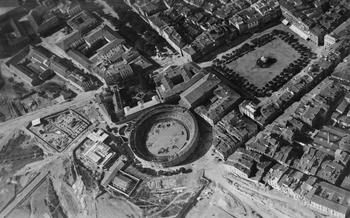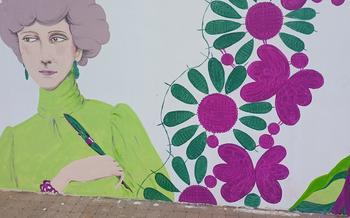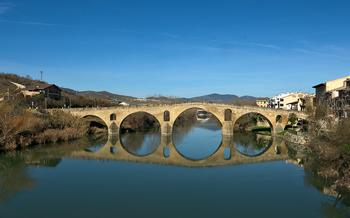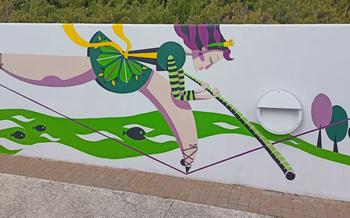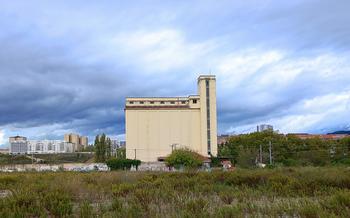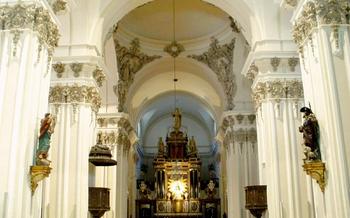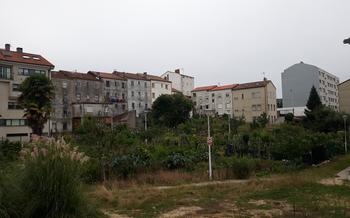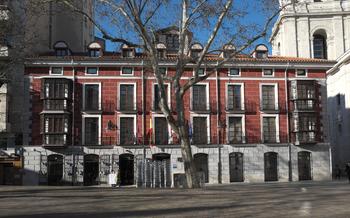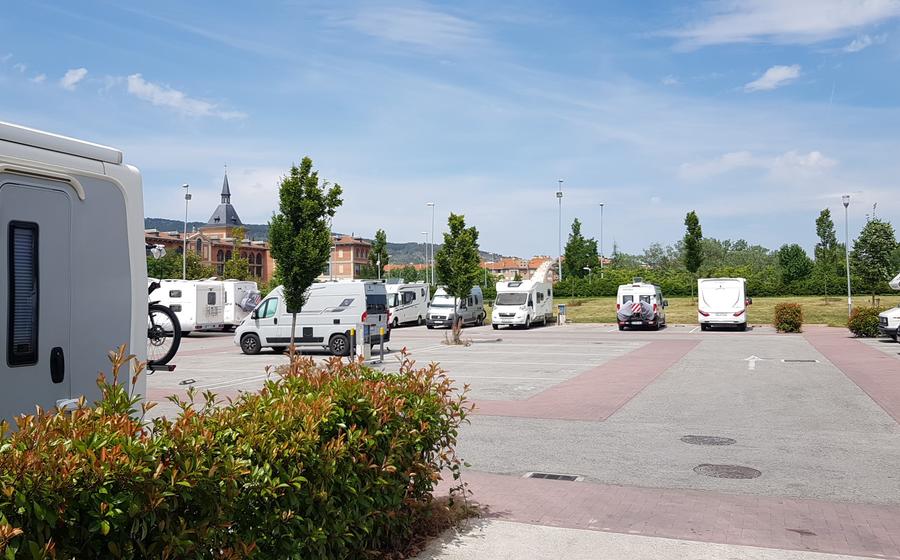
Ermita de la Virgen del Yugo Sanctuary
- Yoke
- Religious Significance of the Sanctuary
- Artistic Treasures of the Sanctuary
- Visiting the Ermita de la Virgen del Yugo Sanctuary
- Attending Mass or Religious Services
- Exploring the Surroundings of the Sanctuary
- Participating in Local Festivals and Events
- Learning about Local History and Culture
- Finding Accommodation and Dining Options
- Shopping for Souvenirs and Local Crafts
- Exploring the Region of Pamplona
- Booking a Guided Tour or Pilgrimage
- Planning Your Visit During the Off-Season
- Insider Tip: Discovering Hidden Gems
Yoke
The Ermita de la Virgen del Yugo Sanctuary is a revered pilgrimage site located in Pamplona, Spain. Its origins can be traced back to the 12th century when, according to legend, a shepherd named Domingo discovered a statue of the Virgin Mary hidden inside a hollow tree trunk. This miraculous event led to the construction of a small chapel on the spot, which later evolved into the magnificent sanctuary we see today. In the 16th century, the chapel was expanded and transformed into a Gothic-style church. The sanctuary underwent further renovations in the 18th and 19th centuries, resulting in the eclectic architectural style that blends Gothic, Renaissance, and Baroque elements. The sanctuary has withstood the test of time, surviving wars, natural disasters, and societal changes, becoming a symbol of resilience and devotion in the region.
Religious Significance of the Sanctuary
The Ermita de la Virgen del Yugo Sanctuary holds a profound religious significance for the people of Pamplona and the surrounding region. Dedicated to the Virgin of the Yoke, the sanctuary has become a revered pilgrimage site, attracting devout Catholics from far and wide. The Virgin of the Yoke, also known as the Virgen del Yugo, is deeply venerated as the patroness of Pamplona. Her image, crafted with exquisite detail, adorns the main altarpiece of the sanctuary, drawing countless pilgrims and worshippers who seek her intercession and blessings.
Throughout the year, the sanctuary hosts numerous religious festivities and events that honor the Virgin of the Yoke and celebrate her miraculous interventions. The most prominent celebration is the annual Feast of the Virgin of the Yoke, which takes place on September 8th. During this grand festival, pilgrims flock to the sanctuary to pay homage to their beloved patroness. The festivities include solemn processions, heartfelt masses, and vibrant cultural performances that showcase the deep devotion of the local community.
The sanctuary serves as a spiritual haven, where visitors can find solace and seek divine guidance. The serene atmosphere, coupled with the exquisite artwork and religious symbols, fosters an environment conducive to prayer and contemplation. For the local community, the Ermita de la Virgen del Yugo Sanctuary represents a sacred space where tradition, faith, and devotion intertwine, creating a tangible connection between the past and the present.
Artistic Treasures of the Sanctuary
The artistic heritage of the Ermita de la Virgen del Yugo Sanctuary is as captivating as its religious significance. The main altarpiece, a stunning masterpiece carved in polychromed wood, takes center stage in the sanctuary's interior. Its intricate carvings depict scenes from the life of the Virgin Mary and the life of Christ, showcasing the exceptional craftsmanship of its creators. The altarpiece is not only a testament to the artistic prowess of the era but also a profound expression of devotion and faith.
Beyond the main altarpiece, the sanctuary boasts a collection of notable artworks and sculptures that contribute to its artistic allure. Paintings depicting religious scenes, delicate sculptures of saints and angels, and intricate stained glass windows adorn the walls and alcoves, creating a visually stunning and spiritually uplifting atmosphere. Each artwork holds its own historical and cultural significance, providing a glimpse into the artistic traditions and beliefs of the time.
The conservation and preservation of these artistic treasures are of utmost importance. The sanctuary authorities and local communities have taken meticulous care to restore and maintain these artworks, ensuring their preservation for future generations. Through ongoing conservation efforts, the sanctuary remains a living testament to the rich artistic heritage of the region, showcasing the enduring power of faith and the beauty of religious expression.
Visiting the Ermita de la Virgen del Yugo Sanctuary
The Ermita making it easily accessible by foot or public transportation. The sanctuary is open to visitors daily, with varying hours of operation depending on the season. Admission to the sanctuary is free of charge, allowing pilgrims and tourists alike to experience its sacred atmosphere without financial constraints. Guided tours are available for those seeking a deeper understanding of the sanctuary's history, architecture, and religious significance. Visitors can also opt for self-guided exploration, immersing themselves in the sanctuary's tranquil ambiance at their own pace.
When visiting the sanctuary, appropriate etiquette and dress code are essential to show respect for its sacred nature. Visitors are encouraged to dress modestly and maintain a respectful demeanor while exploring the sanctuary's grounds and interior. Photography is permitted within the sanctuary, but using flash or tripods is generally discouraged to avoid disturbing other visitors or disrupting religious services.
Attending Mass or Religious Services
Attending mass or religious services at the Ermita de la Virgen del Yugo Sanctuary offers a profound spiritual experience, allowing visitors to immerse themselves in the devout traditions of the local community. The sanctuary hosts a regular schedule of masses and religious services, including daily mass, weekly adoration, and special services during religious holidays and festivals.
Participation in these services provides an opportunity to witness the deep faith and devotion of the local Catholic community. Visitors can join in the communal prayers, listen to inspiring sermons, and receive blessings from the resident priests. For those seeking a deeper spiritual connection, the sanctuary also offers opportunities for private prayer and reflection in its tranquil and sacred atmosphere.
Local customs and traditions play a significant role during religious services at the sanctuary. Visitors are encouraged to dress respectfully and observe the local customs and etiquette. This includes maintaining silence during mass, following the lead of the congregation for responses and gestures, and receiving communion in a reverent manner.
By attending mass or religious services at the Ermita de la Virgen del Yugo Sanctuary, visitors can gain a deeper understanding of the religious significance of the site and experience the vibrant faith and devotion of the local community.
Exploring the Surroundings of the Sanctuary
Beyond the sacred confines of the Ermita de la Virgen del Yugo Sanctuary, the surrounding landscape beckons with its natural beauty and rich history. Wander through the serene countryside, where olive groves and vineyards paint a picturesque tapestry. Follow winding paths that lead to hidden valleys, cascading waterfalls, and breathtaking viewpoints.
Lace up your hiking boots and embark on an invigorating trek along the many trails that crisscross the region. Admire the stunning vistas that unfold before you, where the patchwork of fields, forests, and distant mountains creates a captivating panorama. Take a moment to pause and soak in the tranquility of nature's embrace.
Discover nearby attractions that offer a glimpse into the region's past and present. Visit the charming villages nestled amidst rolling hills, where time seems to stand still. Explore ancient ruins, medieval castles, and historic churches that tell tales of bygone eras. Immerse yourself in the local culture by visiting traditional markets, artesanía shops, and museums that showcase the region's unique heritage.
Whether you seek solitude in nature, an adrenaline-pumping adventure, or a journey into the past, the surroundings of the Ermita de la Virgen del Yugo Sanctuary offer a wealth of experiences that will enrich your visit. Embrace the opportunity to venture beyond the sanctuary walls and discover the hidden gems that await.
Participating in Local Festivals and Events
The Ermita de la Virgen del Yugo Sanctuary is not just a place of religious devotion but also a vibrant hub for local festivities and events. Each year, the sanctuary becomes the center of celebrations honoring the Virgin of the Yoke, drawing pilgrims and visitors from all over the region.
The annual festivities, typically held in September, are a spectacle of music, dance, and cultural performances. The streets surrounding the sanctuary come alive with processions, parades, and traditional Basque dances performed by local groups. The air is filled with the sounds of music, laughter, and the sweet aroma of local cuisine.
During these festivities, visitors can witness the deep-rooted traditions and customs of the Basque people. They can join in the dancing, sample the local gastronomy, and experience the warmth and hospitality of the community. Whether you're a devout pilgrim or simply seeking a unique cultural experience, participating in these local festivals offers an unforgettable glimpse into the heart of Basque culture.
Learning about Local History and Culture
The region surrounding the Ermita de la Virgen del Yugo Sanctuary is steeped in a rich history and vibrant culture. Visitors can immerse themselves in the local traditions and heritage through various avenues. The nearby town of Pamplona, the capital of the Navarre region, is home to several museums and cultural centers that showcase the region's history, art, and folklore. The Museo de Navarra, in particular, is a must-visit for those interested in learning about the region's past, from prehistoric times to the present day.
For a deeper dive into the local culture, visitors can attend traditional festivals and events held throughout the year. These celebrations offer a glimpse into the region's unique customs and traditions. The annual Fiesta de San Fermín, held in July, is one of the most famous festivals in Spain and attracts visitors from around the world. This week-long celebration features bull runs, parades, concerts, and traditional Basque dancing.
To truly experience the local way of life, visitors can venture into the surrounding villages and towns. Each village has its own unique charm and traditions, offering a glimpse into the authentic culture of the region. Visitors can interact with the locals, sample the regional cuisine, and learn about the customs and traditions that have been passed down through generations.
Finding Accommodation and Dining Options
The Ermita de la Virgen del Yugo Sanctuary is located in a rural area with limited accommodation options, but there are several charming hotels and guesthouses in the nearby town of Pamplona. These offer a range of choices to suit different budgets and preferences, from cozy bed and breakfasts to upscale boutique hotels.
For a truly authentic experience, consider staying in a traditional casa rural (country house), which offers a chance to immerse yourself in the local culture and enjoy homemade cuisine. There are also several hostals (hostels) and albergues (pilgrim hostels) in the area, providing budget-friendly options for backpackers and pilgrims.
When it comes to dining, the surrounding area offers a variety of restaurants and cafes serving delicious local cuisine. From traditional Spanish dishes like paella and cocido to fresh seafood and locally produced wines, there's something to tempt every palate.
For a truly memorable dining experience, try one of the many asadores (grill restaurants) in the region, where you can savor succulent grilled meats and vegetables cooked over an open fire. Don't miss the opportunity to indulge in the region's famous pintxos (small tapas-like snacks) served in local bars, a great way to sample a variety of local flavors.
Shopping for Souvenirs and Local Crafts
The Ermita de la Virgen del Yugo Sanctuary is located in a charming town known for its vibrant local culture and traditional crafts. Take some time to explore the local markets and artesanía shops, where you can find unique souvenirs and handicrafts to cherish.
Support local artisans and businesses by purchasing handmade pottery, intricate jewelry, woven textiles, and other beautiful items. These souvenirs will not only remind you of your visit but also contribute to the preservation of local traditions.
When shopping for souvenirs, be sure to ask the artisans about the stories and techniques behind their work. This will give you a deeper appreciation for the craftsmanship and cultural significance of the items you purchase.
Some insider tips for finding the best souvenirs include visiting the weekly market, where local artisans often set up stalls, and exploring the narrow streets and hidden corners of the town, where you may find unique shops and workshops.
Remember to haggle politely with the vendors, as this is a common practice in many local markets. However, be respectful and fair in your negotiations, as these artisans rely on their sales for their livelihood.
Happy shopping, and may your souvenirs bring back fond memories of your time at the Ermita de la Virgen del Yugo Sanctuary!
Exploring the Region of Pamplona
The city of Pamplona, where the Ermita de la Virgen del Yugo is situated, offers an array of captivating attractions and landmarks that complement the religious and cultural significance of the sanctuary. Embark on a journey through the heart of Pamplona and discover its rich history, vibrant culture, and architectural wonders.
Strolling through the city's enchanting streets, you'll encounter the Plaza del Castillo, the bustling main square that serves as a focal point for locals and visitors alike. Admire the elegant facades of the surrounding buildings, including the majestic Palacio de Navarra, the seat of the regional government.
Delve into the city's artistic heritage at the Museo de Navarra, which houses an impressive collection of artworks from various periods, including medieval sculptures, Renaissance paintings, and contemporary masterpieces. Don't miss the opportunity to witness the running of the bulls, a thrilling event that takes place during the annual San Fermín festival, where brave participants test their courage by running alongside the bulls through the city streets.
Venture beyond the city center to explore the picturesque countryside of Navarra, renowned for its natural beauty and charming villages. Embark on a hike through the rolling hills and lush forests, or cycle along scenic trails that wind through vineyards and olive groves. Discover hidden gems like the medieval town of Olite, with its well-preserved castle and narrow cobblestone streets, or the enchanting Foz de Lumbier gorge, where the Aragón River has carved a stunning canyon.
Pamplona and its surroundings offer a harmonious blend of history, culture, and natural wonders. Whether you seek adventure, relaxation, or spiritual enlightenment, this captivating region has something to offer every traveler.
Booking a Guided Tour or Pilgrimage
To make the most of your visit to the Ermita de la Virgen del Yugo Sanctuary, consider booking a guided tour or pilgrimage. Local guides can provide valuable insights into the history, religious significance, and cultural traditions associated with the sanctuary. They can also help you navigate the area and ensure you don't miss any important sights or experiences.
Organized pilgrimages are also available for those seeking a deeper spiritual connection to the sanctuary. These pilgrimages often include guided walks, prayers, and other religious rituals. Whether you're a devout pilgrim or simply curious about the sanctuary's spiritual significance, a guided tour or pilgrimage can enhance your visit.
When choosing a tour operator, it's essential to research and select a reputable company. Look for operators that have experience leading tours to the sanctuary and are knowledgeable about the local history and culture. Customizing your tour to your interests is also possible, allowing you to focus on specific aspects of the sanctuary or the surrounding region.
Whether you choose a guided tour or self-guided exploration, visiting the Ermita de la Virgen del Yugo Sanctuary is a rewarding and enriching experience. Immerse yourself in the sanctuary's history, admire its architectural beauty, and discover the deep devotion of the local people.
Planning Your Visit During the Off-Season
While the Ermita de la Virgen del Yugo Sanctuary is a popular destination year-round, visiting during the off-season (typically from November to March) offers several advantages. During this time, you'll encounter fewer crowds, allowing you to enjoy a more peaceful and intimate experience. The cooler temperatures are also ideal for exploring the surrounding countryside and engaging in outdoor activities.
One of the main benefits of visiting during the off-season is the potential for discounts and special offers. Many hotels, restaurants, and tour operators offer reduced rates and packages during this time to attract visitors. This can be a great way to save money while still enjoying all that the sanctuary and the region have to offer.
To make the most of your off-season visit, plan your trip in advance and be flexible with your schedule. Research local events and festivals that may be taking place during your stay. Also, consider hiring a local guide who can provide insights into the history and culture of the region and take you to hidden gems that you might not discover on your own.
Remember, the off-season is an excellent time to experience the sanctuary and its surroundings without the hustle and bustle of peak tourist season. Embrace the tranquility, take advantage of the special offers, and enjoy a truly authentic and memorable visit.
Insider Tip: Discovering Hidden Gems
Beyond the main tourist attractions, Pamplona and its surrounding region offer a wealth of hidden gems waiting to be discovered by curious travelers. Seek out the secluded Ermita de San Pedro, a charming 12th-century hermitage nestled amidst rolling hills. Admire the intricate Gothic architecture of the Iglesia de Santa María la Real, a hidden gem tucked away in the heart of the old town. Escape the crowds and find tranquility at the tranquil Parque de la Taconera, a beautiful green space with lush gardens and a serene lake. For an authentic culinary experience, venture into the bustling Mercado de Santo Domingo, a vibrant market where you can savor local delicacies and interact with friendly vendors. Explore the atmospheric streets of the old Jewish quarter, known as La Judería, and discover its rich history and cultural heritage. With a little curiosity and exploration, you'll uncover the hidden treasures that make Pamplona truly special.
